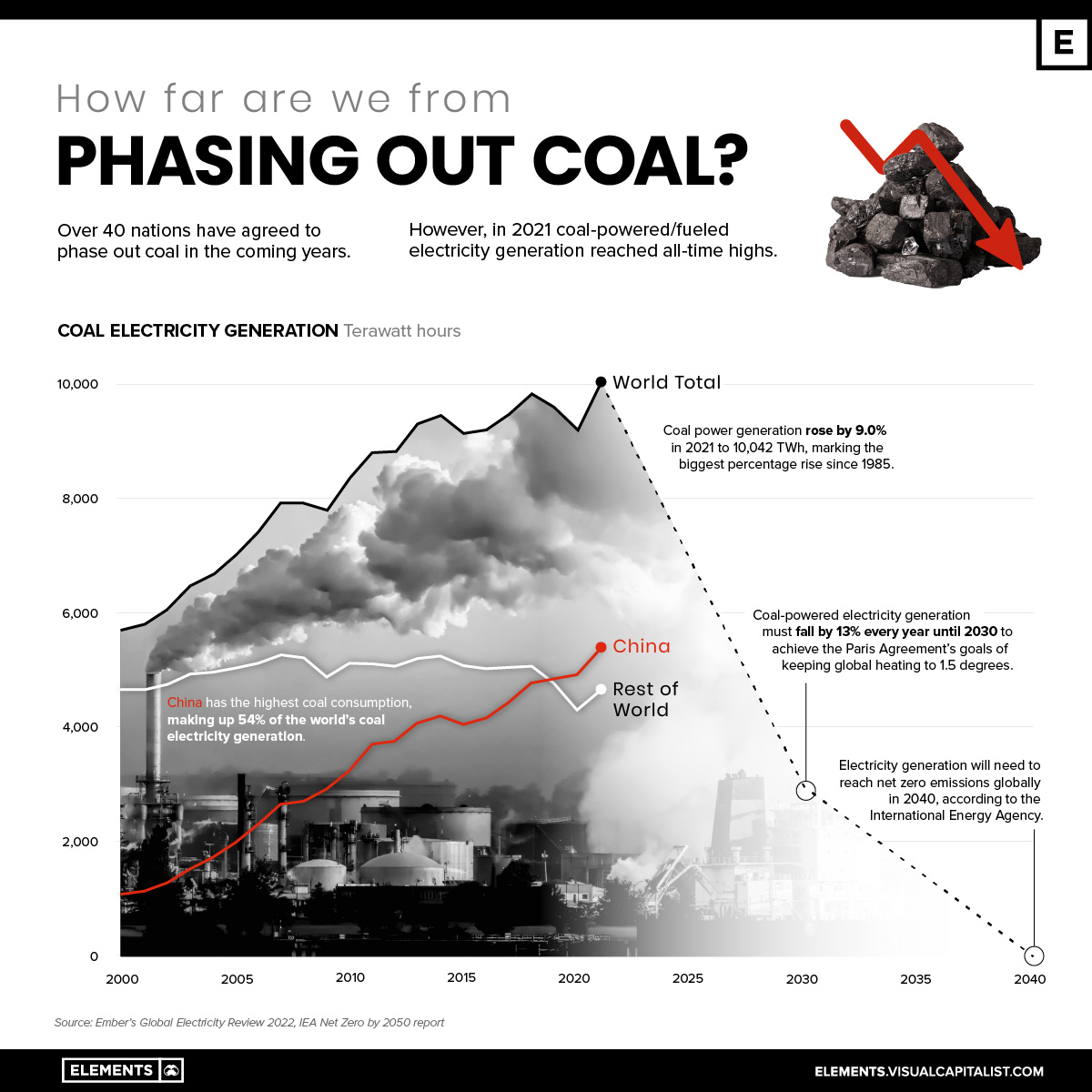In 2021, coal-fired electricity generation increased by 9% reaching all-time highs globally, showing that eliminating coal from the energy mix will not be a simple task despite 40 nations agreeing at the COP26 conference last year to phase coal out of their energy mixes. This infographic shows the aggressive phase-out of coal power that would be required in order to reach net zero goals by 2050.
This version of the original article by Bruno Venditti (visualcapitalist.com) has been edited [ ] and abridged (…) to provide you with a faster and easier read. Also note that this complete paragraph must be included in any re-posting to avoid copyright infringement.

China has the highest coal consumption, making up 54% of the world’s coal electricity generation. The country’s consumption jumped 12% between 2010 and 2020, despite coal making up a lower percentage of the country’s energy mix in relative terms.
| Top Consumers | 2020 | Share |
|---|---|---|
China  |
82.3 | 54.3% |
India  |
17.5 | 11.6% |
United States  |
9.2 | 6.1% |
Japan  |
4.6 | 3.0% |
South Africa  |
3.5 | 2.3% |
Russia  |
3.3 | 2.2% |
Indonesia  |
3.3 | 2.2% |
South Korea  |
3.0 | 2.0% |
Vietnam  |
2.1 | 1.4% |
Germany  |
1.8 | 1.2% |
Together, China and India account for 66% of global coal consumption and emit about 35% of the world’s greenhouse gasses (GHG). If you add the United States to the mix, this goes up to 72% of coal consumption and 49% of GHGs.
According to the United Nations, emissions from current and planned fossil energy infrastructure are already more than twice the amount that would push the planet over 1.5°C of global heating, a level that scientists say could bring more intense heat, fire, storms, flooding, and drought than the present 1.2°C.
Coal-powered electricity generation must fall by 13% every year until 2030 to achieve the Paris Agreement’s goals of keeping global heating to only 1.5 degrees and, to reach the mark, countries would need to speed up the shift from their current carbon-intensive pathways to renewable energy sources like wind and solar.
How fast the transition away from coal will be achieved depends on a complicated balance between carbon emissions cuts and maintaining economic growth, the latter of which is still largely dependent on coal power.
Related Articles From the munKNEE Vault:
1. Wind Power Generation By U.S. State – How Is Your State Doing?
Wind power is the most productive renewable energy source in the U.S., generating nearly half of America’s renewable energy and today’s infographic shows how much wind electricity different U.S. states generate, and breaks down wind’s share of total electricity generation in top wind power producing states.
2. Wind & Solar Power Generation By Country – How Is Your Country Doing?
Wind and solar generate over a tenth of the world’s electricity as illustrated in today’s infographic and, taken together, they are the fourth-largest source of electricity, behind coal, gas, and hydro. This version of the original article by Bruno Venditti (visualcapitalist.com) has been edited [ ] and abridged (…) to provide you with a faster and easier read. Also note that this complete …
 munKNEE.com Your Key to Making Money
munKNEE.com Your Key to Making Money
To tell the truth, it is so sad that China has the highest coal consumption because it can have disastrous consequences for all the world and it may not have the reverse effect. Of course, it is really important to fight this situation and move in the right direction, trying to change such a state of affairs because a greener future begins with the transition from coal to alternative energy sources. I think that if we continue to be at the same stage and if we don’t develop effective methods to switch to renewable energy sources, we will not achieve a sustainable future soon. It is an indisputable fact that coal is one of the main sources of local environmental pollution and climate change. I think that it is necessary for countries to speed up the shift from their current carbon-intensive pathways to renewable energy sources because this is the only way to get it off the ground and make a breakthrough.